Introduction
Blueberries are native to eastern North America and are one of the few crop plants that originated here. The woods and swamps of Florida are populated with at least eight wild blueberry species, including highbush blueberry (Vaccinium corymbosum), rabbiteye blueberry (Vaccinium virgatum), and evergreen blueberry (Vaccinium darrowii). Wild blueberries are present nearly everywhere in Florida, except in areas where soil pH is above 6.0. This publication provides historical background on southern highbush blueberries (SHB) and information on specific UF/IFAS cultivars that can be a helpful resource for SHB growers. The intended audience is primarily Florida commercial blueberry growers but also commercial growers in other locations growing UF/IFAS cultivars. Table 1 provides information on plant and berry characteristics for selected cultivars.
Efforts to breed new blueberry cultivars that were adapted to Florida’s mild winter climate and would ripen in April and May began in the 1950s, under the direction of Dr. Ralph Sharpe at the University of Florida. By crossing northern highbush cultivars with Vaccinium species found throughout Florida and the southeastern United States, Sharpe developed a new type of blueberry known as the southern highbush. Southern highbush blueberries combine the fruit quality and productivity of highbush blueberries with the low chilling requirement necessary to produce a crop in the Florida climate. In 1976 and 1977, the UF/IFAS blueberry breeding program released three southern highbush blueberry varieties (‘Sharpblue’, ‘Flordablue’, and ‘Avonblue’) that were bred specifically for Florida's mild climate and showed promise for producing early-ripening, high-quality fruit. By 1983, a small blueberry shipping industry was established in Florida. Because these southern highbush blueberries ripened earlier than blueberries from other areas, they brought very high prices. High prices and ready markets have led to the expansion of Florida's bearing blueberry acreage. Between 1982 and 2015, Florida blueberry acreage has increased from less than 1,000 acres to over 5,700 acres, and additional plantings are anticipated. During the 1980s and early 1990s, more than half of the Florida blueberry acreage consisted of rabbiteye varieties. Beginning in the early to mid-1990s, most new blueberry plantings in Florida consisted of southern highbush. With the exception of small U-pick farms, Florida’s blueberry acreage currently consists almost entirely of southern highbush varieties, mostly developed by the UF/IFAS breeding program.
As many new southern highbush plantings have come into bearing, annual statewide blueberry production has steadily increased from about 1.5 million pounds in the early 1990s to over 21 million pounds in 2022. Fresh fruit prices have remained high relative to other US states for early-ripening southern highbush varieties. However, production problems have been numerous and sometimes severe. Although many aspects of blueberry growing in Florida are better understood than they were in the 1990s, blueberries remain a difficult crop to grow in Florida. Very early flowering makes southern highbush blueberries susceptible to late winter/early spring freezes, especially in the northern area of the state. Recently, new diseases such as algal stem blotch and bacterial wilt have been observed in commercial blueberry plantings in Florida. Although potentially profitable, blueberry fields can be expensive to establish. Prospective southern highbush growers should be aware of establishment costs such as overhead irrigation for freeze protection and large quantities of soil amendments, such as pine bark, that are necessary to improve pH and organic matter content.
The major incentive for growing blueberries in Florida is the market window available for blueberries that ripen during March and April. In recent years, blueberries have been planted in the Southern Hemisphere for shipping to the Northern Hemisphere during the period from November to March. Southern highbush blueberries are being planted in south Georgia, along the Gulf Coast to east Texas, in California, and in Mexico. Nevertheless, the market period during March and April is still available to Florida growers, and fruit prices in most years are usually profitable until late April, when harvests of the Georgia and North Carolina crops begin to rapidly increase market volumes. In recent years, there has been an increase in the importation of blueberries from Mexico during this market period, which is expected to continue to increase.
Depending on climatic conditions and cultivar, southern highbush blueberries may be grown using the traditional winter-dormancy production system (which may or may not include use of hydrogen cyanamide) or the “evergreen” or nondormant system. The evergreen system is used under conditions of very low winter chilling in central and south-central production areas of Florida or under tunnels in central and north-central Florida. Only certain cultivars are well-suited for evergreen production (see individual cultivar descriptions). Tunnels represent a substantial increase in production cost, although they may make economic sense to the extent they increase yield or allow earlier fruit maturity. For more information on the use of hydrogen cyanamide for traditional winter-dormancy production systems, see Ask IFAS publications HS1156, “2024 Florida Blueberry Integrated Pest Management Guide” (https://edis.ifas.ufl.edu/hs380) and HS976, “Reproductive Growth and Development of Blueberry” (https://edis.ifas.ufl.edu/hs220).
Cultivars
Many improved southern highbush cultivars have been developed by the UF/IFAS breeding program since the initial releases of ‘Sharpblue’, ‘Flordablue’, and ‘Avonblue’ in the mid-1970s. Southern highbush blueberries are grown in several areas of the world today, and many originate from germplasm developed in the UF/IFAS blueberry breeding program. There are more blueberry cultivar choices available for Florida growers than ever before, and the UF/IFAS blueberry breeding program continues to develop new cultivars with a focus on several key characteristics to help growers be more successful and profitable.
Cultivar selection involves weighing the advantages and disadvantages of a cultivar relative to the grower’s needs. Unfortunately, there are no perfect cultivars suited for every location and management system. The following discussion categorizes southern highbush cultivars into three groups: (1) new cultivars, (2) established cultivars, and (3) secondary and obsolete cultivars. Proper cultivar selection is critical to a successful blueberry enterprise, and growers should seek information from multiple sources, including their local county UF/IFAS Extension office. For more detailed cultivar performance information and data, see https://www.blueberrybreeding.com/varieties and the UF/IFAS Blueberry Growers Guide app (available for both iOS and Android systems).
Average Yields
The historical average annual yield per acre in Florida is between 4,000 and 6,500 pounds per acre (at 1,742 plants per acre). However, the newest University of Florida southern highbush blueberry cultivars have the potential to achieve higher average annual yields, with a range of 10,000 to 25,000 pounds per acre observed in research trials. While older cultivars produced little if anything in the first year, the newest UF cultivars can achieve marketable yields beginning in the first year (12 months after planting in the field), with yields of up to 9,000 pounds per acre or higher observed in some cases.
New Cultivars
New cultivars are continually being released from the UF/IFAS blueberry breeding program and are expected to exhibit improvements for certain traits compared to existing cultivars. However, compared to major cultivars, new cultivars have not been observed for as many years or under as many different production systems and conditions. While new cultivars may represent significant improvements for certain traits, growers should proceed cautiously with new cultivars until they gain experience with their performance under a particular management system at their location.
'Falcon' (U.S. Patent PPAF) (Figure 1) is one of two new releases from the University of Florida, approved for release in 2023. ‘Falcon’ is a vigorous, very high-yielding, early-season cultivar for the evergreen production system, with no known disease or pest issues. Very high yields have been documented for several years in south Florida under the evergreen system. The fruit is jumbo, very firm, with high wax bloom and a long postharvest life. It has received high scores for flavor in consumer taste panels.
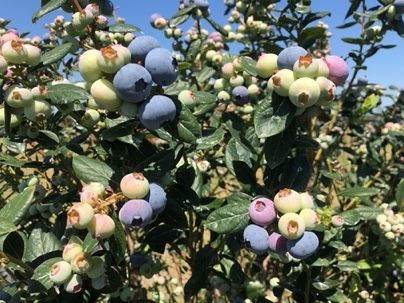
Credit: UF/IFAS Blueberry Breeding Program
‘FL19-006’ (U.S. Patent PPAF) (Figure 2) is one of the newest releases from the University of Florida, approved for release in 2023. It is a vigorous, high-yielding, early-season cultivar for the evergreen production system, with no known disease or pest issues. The fruit is jumbo-sized, sweet and firm, with a high wax bloom and a long postharvest life. It has achieved high flavor scores in taste panels.
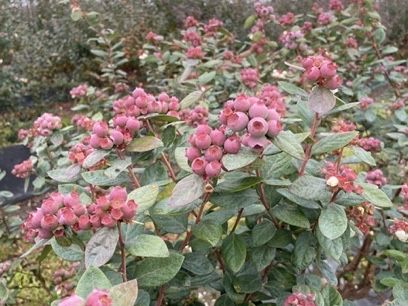
Credit: UF/IFAS Blueberry Breeding Program
‘Albus’ (U.S. Patent PPAF) (Figure 3) was approved for release in 2022. It is a vigorous, high-yielding cultivar for the evergreen production system, selected for the central Florida region. Albus begins harvesting early and continues through the end of the Florida season. Fruit is firm with a heavy wax bloom and received high scores in consumer taste panels.
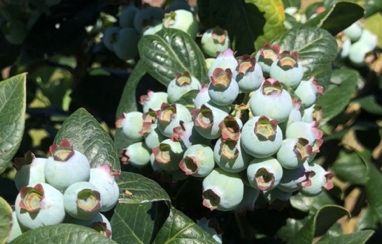
Credit: UF/IFAS Blueberry Breeding Program
‘Sentinel’ (U.S. PP33,896) (Figure 4) was approved for release in 2020. ‘Sentinel’ is a vigorous, early-season, high-yielding cultivar with no known disease issues. The fruit is a little firmer than ‘Emerald’ and has scored high in consumer taste panels. It has performed well across the state and is suitable for machine harvesting. ‘Sentinel’ does not need hydrogen cyanamide applications.
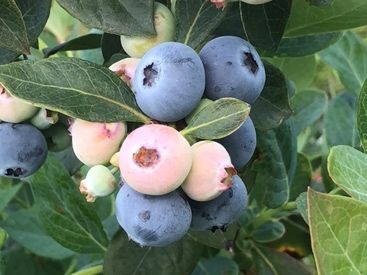
Credit: UF/IFAS Blueberry Breeding Program
‘Colossus’ (U.S. PP33,802) (Figure 5) was approved for release in 2019. It has very large to jumbo-sized fruit with very high fruit firmness and has performed well in machine harvest trials. It also has concentrated ripening and good early natural leafing. ‘Colossus’ blooms somewhat later with a short bloom-to-ripening period (fitting well within the Florida market window) and appears to be best adapted to the north-central Florida region. Trials are ongoing in the central Florida region.
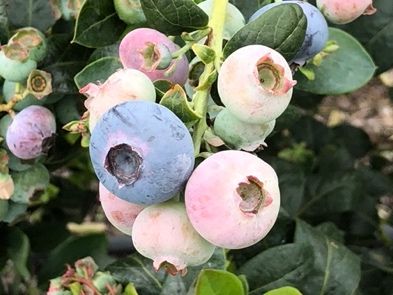
Credit: UF/IFAS Blueberry Breeding Program
‘Magnus’ (U.S. PP32,181) (Figure 6) was approved for release in 2017. It is an early-maturing cultivar for hand harvest during the Florida window for the fresh fruit market. ‘Magnus’ is very consistent across seasons and has been successful in both hydrogen cyanamide and non-hydrogen cyanamide production systems. However, if hydrogen cyanamide is used in production, only very low doses are recommended. The fruit is large (similar to ‘Emerald’), although not considered firm enough for machine harvesting. It is less vigorous than ‘Emerald’ and may require freeze protection in January. Due to somewhat higher chilling requirements, ‘Magnus’ is best adapted to the north-central Florida region.
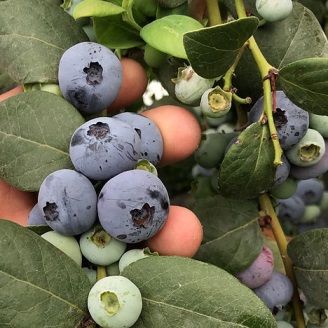
Credit: UF/IFAS Blueberry Breeding Program
‘Optimus’ (U.S. PP32,028) (Figure 7) was also approved for release in 2017. It is an early-maturing cultivar suitable for machine harvest for the fresh market. Berries are firm, medium-sized, and high quality, and the bush has good natural leafing. No or very low doses of hydrogen cyanamide are suggested because high damage from traditional doses has been observed. Some chilli thrips damage has been observed in the summer, as well as rust in evergreen production systems, but no reduction in yield has been observed. ‘Optimus’ may require freeze protection in January. ‘Optimus’ has been reported to produce well across all of Florida, with the best production in north Florida.
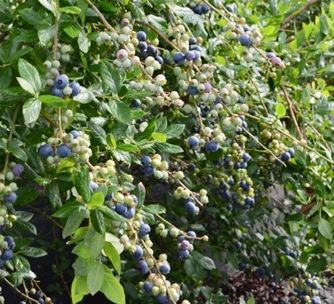
Credit: UF/IFAS Blueberry Breeding Program
Established Cultivars
For well over a decade, ‘Emerald’, ‘Jewel’, and ‘Star’ comprised the backbone of the Florida blueberry industry. There are now newer cultivars (listed under both “New Cultivars” and “Established Cultivars”) that address specific needs such as higher yield, increased earliness, higher fruit quality, and the potential for mechanical harvest.
‘Arcadia’™ (U.S. PP26,313) (Figure 8) is a very low-chill cultivar released by the University of Florida in 2015. It has high yield in evergreen management systems, with peak production in central and south-central Florida during the high-value market window. The fruit is large and sweet. Plants have established well in the field and have high tolerance to leaf diseases. In 2016, bacterial wilt (Ralstonia solanacearum) was found on ‘Arcadia’™ at several locations in Florida. This serious disease can kill plants and spread rapidly through a blueberry field. By 2018, Ralstonia had been found in other cultivars as well. Research into the susceptibility of all cultivars is ongoing. ‘Arcadia’™ is still widely planted in central and south-central Florida because of its high yield. ‘Arcadia’™ is best adapted to central and south-central Florida.
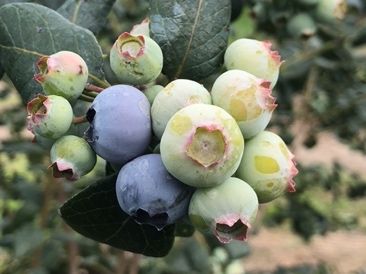
Credit: UF/IFAS Blueberry Breeding Program
‘Avanti’™ (U.S. PP26,312) (Figure 9) is a very early-ripening cultivar with a very low chill requirement, released by the University of Florida in 2015. Yield potential in an evergreen system is above average. The fruit are firm and high quality, with a small, dry picking scar. Fruit can be smaller compared to some other cultivars, particularly late in the season. Susceptibility to Botrytis fruit rot has been reported. ‘Avanti’™ also has higher susceptibility to damage from mites and chilli thrips. Early bloom may require longer periods of freeze protection in certain regions. ‘Avanti’™ is well-suited for evergreen production in low-chill regions of central and south-central Florida, where fruit has ripened as early as late January.
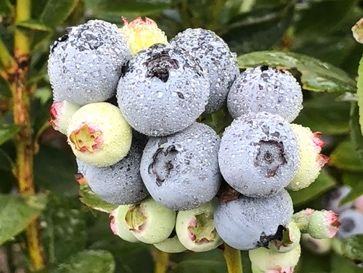
Credit: UF/IFAS Blueberry Breeding Program
‘Emerald’ (U.S. PP12,165) (Figure 10) was released by the University of Florida in 1999 and is one of the most widely planted cultivars in central Florida. ‘Emerald’ combines a vigorous, upright-spreading bush with high yield potential and large, high-quality berries. ‘Emerald’ flowers open uniformly. It produces abundant leaves but may benefit from hydrogen cyanamide applications. Because the plants are highly vigorous when planted on suitable soils, ‘Emerald’ is capable of carrying heavy crops and is generally considered one of the higher-yielding cultivars grown in central Florida. Fruit clusters are tight and do not ripen uniformly, which makes ‘Emerald’ more difficult to handpick than many cultivars. ‘Emerald’ is considered a mid-season cultivar for Florida with an extended harvest season. ‘Emerald’ is best adapted for planting in north-central and central Florida.
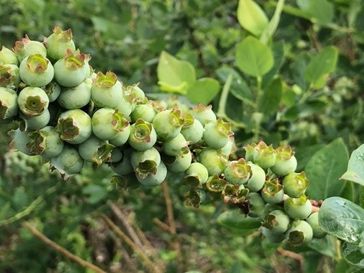
Credit: UF/IFAS Blueberry Breeding Program
‘Farthing’ (U.S. PP19,341) (Figure 11) was released by the University of Florida in 2007. It is vigorous with a compact growth habit and numerous branches. Flowering occurs after ‘Emerald’. ‘Farthing’ flowers profusely and sets heavy crops with a long harvest season. Berry size is usually medium due to heavy crop loads but can be large with lighter crops. Berry firmness is exceptional, with a nearly crisp texture. Scar and flavor are good. Berry color is darker than average, with below-average uniform color development at ripening. This is due to a tendency for the stem end of the berry to remain red or purple, especially when plants are carrying heavy crops or in tunnel production. Because of its fruit firmness and ability for ripe fruit to persist on the bush longer than average, ‘Farthing’ has been successfully harvested using machines under commercial production. ‘Farthing’ is best adapted for planting in north-central Florida, although in some cases, it has been successfully grown in central Florida.
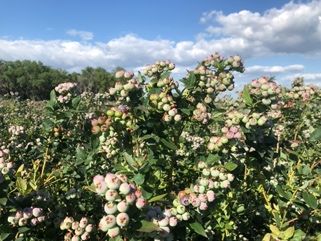
Credit: UF/IFAS Blueberry Breeding Program
‘Kestrel’™ (U.S. PP21,719) (Figure 12) was released by the University of Florida in 2009. ‘Kestrel’™ is a low-chill cultivar that blooms early and ripens very early. Berries are medium to large, with excellent flavor and low detachment force. Early leafing and flowering make ‘Kestrel’™ particularly susceptible to late freezes. Berry detachment force is lower than average for blue fruit, which can result in fruit loss following storms or windy conditions and may limit its potential for machine harvesting. Mite and thrip infestations have been reported on ‘Kestrel’™. ‘Kestrel’™ is best adapted to central and south-central Florida.
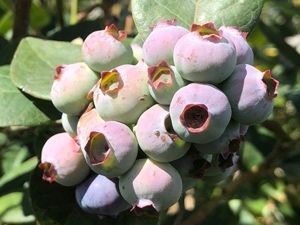
Credit: UF/IFAS Blueberry Breeding Program
‘Patrecia’ (U.S. PP27,740) (Figure 13) is an early- to mid-maturing cultivar released by the University of Florida in 2016. It has an upright architecture and high yield with adequate chilling. Late blooming may require less freeze protection compared to other cultivars. Berries are large with very uniform ripening, but they have a larger-than-desired picking scar that can tear during harvest. The fruit cluster is tight, which requires hand harvesting, so machine harvesting is not recommended (using current technology). This cultivar produces best with a hydrogen cyanamide management system. Due to a somewhat higher chilling requirement, ‘Patrecia’ is best adapted to north-central Florida.
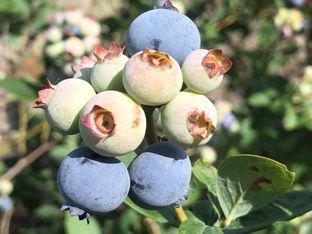
Credit: UF/IFAS Blueberry Breeding Program
Secondary and Obsolete Cultivars for Florida
Secondary and obsolete cultivars are not planted as widely in Florida as established cultivars due to limitations regarding chilling requirements, time of production, fruit characteristics, and diseases/pests. Although no longer recommended for new plantings in Florida, they are still planted to some degree in Florida and may be useful as a minor component of a cultivar mix under certain conditions.
Secondary Cultivars for Florida
‘Chickadee’™ (U.S. PP21,376) (Figure 14) was released by the University of Florida in 2009. ‘Chickadee’™ is a very early-ripening cultivar with a very low chilling requirement. The plant is upright, with stout stems and twigs, and has a narrow, almost monopodial, base. Berries are large and sweet with low acidity and have a firm to semi-crisp texture. Berry quality is maintained on the bush longer than most other cultivars grown in Florida. However, due to a weak root system, plants are prone to uprooting from heavy ice loads during freeze protection or strong storms. In some situations, the weak root system may contribute to lower-than-normal plant vigor and a canopy that can be more sparse than other cultivars. ‘Chickadee’™ does not respond well to heavy pruning, and susceptibility to algal stem blotch has been observed. ‘Chickadee’™ has demonstrated a medium yield potential, low chill requirement, and early maturity. Therefore, ‘Chickadee’™ is best adapted to central and south-central Florida.

Credit: UF/IFAS Blueberry Breeding Program
‘Endura’™ (U.S. PP26,679) (Figure 15) is a low-chill, late-season cultivar released by the University of Florida in 2015. However, it typically produces too late in the Florida market window, and fruit can be tart early in the season. It produces well under both evergreen and hydrogen cyanamide management systems, with a high season-long yield, although the harvest season can be very long and late in an evergreen system. Berries are large and firm, with an excellent, persistent blue color. Some susceptibility to leaf rust and Phytophthora root rot has been reported. ‘Endura’™ is best adapted to central and south-central Florida.
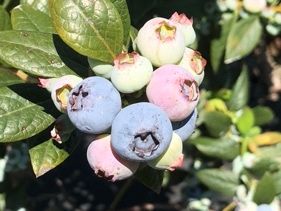
Credit: UF/IFAS Blueberry Breeding Program
‘Indigocrisp’™ (U.S. PP26,523) (Figure 16) is a low-chill cultivar released by the University of Florida in 2013. It has a higher chilling requirement than is typically achieved in Florida. It has excellent field survival and leaf disease tolerance under optimal conditions. Berries are very firm with a crisp texture and a very high sugar-to-acid ratio. ‘Indigocrisp’™ leafs out well, ripens earlier, and has higher yield potential than other crisp-textured cultivars. ‘Indigocrisp’™ shows above-average potential for machine harvest for the fresh market. It has shown some susceptibility to stem blight. This variety has low survival in areas with standing water, so these areas should be avoided. Due to higher chilling requirements, ‘Indigocrisp’™ appears best adapted to regions with chilling greater than Gainesville, Florida.
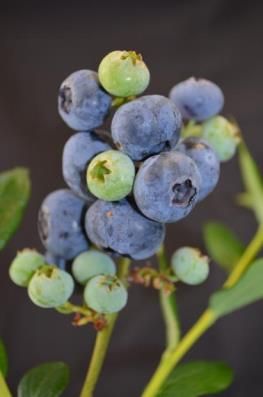
Credit: UF/IFAS Blueberry Breeding Program
‘Jewel’ (U.S. PP11,807) (Figure 17) was released from the University of Florida breeding program in 1998 and has often been planted in combination with ‘Emerald’ in central and north-central Florida. However, ‘Jewel’ is highly susceptible to blueberry rust leaf spot in Florida, and a thorough summer spray program is usually necessary to prevent early fall defoliation. The plant is upright, vigorous, and high-yielding, and it survives well in commercial fields. Under low chilling conditions, ‘Jewel’ is susceptible to injury from hydrogen cyanamide. ‘Jewel’ fruit are slightly smaller and softer than ‘Emerald’, but they are acceptable for commercial packing and shipping. Yield potential is high, and internal berry quality is very good, although berries tend to remain tart until fully ripe. ‘Jewel’ is considered a mid-season cultivar for Florida. ‘Jewel’ is best adapted for planting in north-central and central Florida.
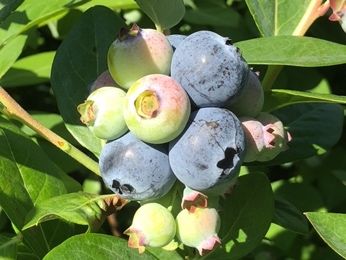
Credit: UF/IFAS Blueberry Breeding Program
‘Keecrisp’™ (U.S. PP27,771) (Figure 18) is a mid- to late-season cultivar released by the University of Florida in 2016. It has a higher chilling requirement than is typically achieved in Florida. It has an upright architecture, with high yield when it receives sufficient chilling, and is best adapted to a hydrogen cyanamide management system. Leafing can be delayed, even with hydrogen cyanamide application. Berries are crisp, with a small, dry picking scar, although coloring at the stem end can be uneven. ‘Keecrisp’™ has demonstrated suitability for machine harvesting for fresh market production. Due to a somewhat higher chilling requirement, ‘Keecrisp’™ is best adapted to areas with chilling higher than Gainesville, Florida.
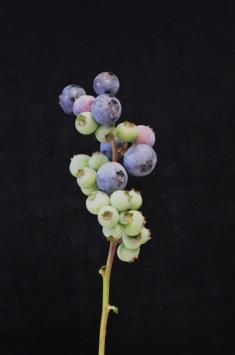
Credit: UF/IFAS Blueberry Breeding Program
‘Meadowlark’™ (U.S. PP21,553) (Figure 19) was released in 2009 by the University of Florida. In recent years, growers in north-central and central Florida have reported pollination issues and low yields on ‘Meadowlark’™. It has greater-than-average susceptibility to bacterial leaf scorch (Xylella fastidiosa), which is observed more frequently in areas prone to flooding, and this has resulted in a decline in some plantings in Florida. It is vigorous with an upright growth habit and a very narrow crown, and it has the ability to leaf strongly during bloom and carry a heavy crop. Berries ripen very early when treated with hydrogen cyanamide. Berries are large to medium-large, depending on the crop load, and berry clusters are loose and easy to harvest because of their exceptionally long pedicels and peduncles. Berries have a mild flavor and are somewhat darker than average. Uniform color development at ripening is below average, with a tendency for red or purple color to persist at the stem end while the rest of the berry is fully blue. Berry firmness is very good. Because of its fruit firmness, ‘Meadowlark’™ has been successfully harvested using machines under commercial production. ‘Meadowlark’™ is best adapted for planting in north-central and central Florida.
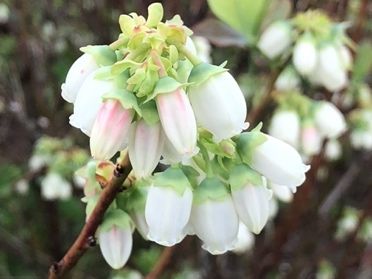
Credit: UF/IFAS Blueberry Breeding Program
‘Primadonna’ (U.S. PP20,181) (Figure 20) was released in 2005 by the University of Florida. It tends to produce well in some years but not others in Florida for reasons that defy a clear explanation. Because of its early maturity and apparent low chilling requirement for the flower buds, ‘Primadonna’ has been planted in central Florida with varying levels of success. In these areas, ‘Primadonna’ may leaf poorly without the benefit of hydrogen cyanamide. However, hydrogen cyanamide often injures ‘Primadonna’ flower buds during low-chill winters. It blooms and ripens early, and its berries are large and have excellent flavor.
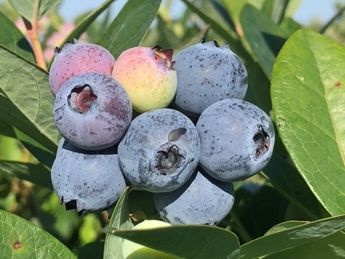
Credit: UF/IFAS Blueberry Breeding Program
‘Springhigh’ (U.S. PP16,476) (Figure 21) was released by the University of Florida in 2004. It was somewhat popular as an earlier-ripening addition to mid-season cultivars such as ‘Emerald’ and ‘Jewel’, especially in central Florida. However, the pack-out for ‘Springhigh’ in Florida has been reduced in some years because of a higher-than-average incidence of soft berries. Picking at frequent intervals during the harvest season is necessary to minimize the occurrence of soft fruit in packing and grading lines. Some packers may not accept ‘Springhigh’ fruit due to postharvest quality issues. Fruit are large and have excellent flavor but have less waxy bloom, making them appear darker than average. Fruit are also softer than most other commercial cultivars. Before planting ‘Springhigh’, growers should carefully evaluate the market potential for this cultivar.

Credit: UF/IFAS Blueberry Breeding Program
‘Snowchaser’ (U.S. PP19,503) was released in 2005 by the University of Florida. It has typically been the earliest-ripening cultivar grown commercially in Florida, although its field survival is considered marginal in Florida due to its susceptibility to stem blight. ‘Snowchaser’ has a very low chilling requirement that usually results in early bloom (early to mid-January in Gainesville), making it particularly susceptible to late winter and early spring freezes. Berries usually begin ripening early in the season when berry prices are typically high. Thus, very early season production is the main objective when growing this cultivar. ‘Snowchaser’ produces medium-sized fruit with excellent flavor and good postharvest characteristics.
‘Sweetcrisp’ (U.S. PP20,027) (Figure 22) was released by the University of Florida in 2005. It has a higher chilling requirement than is typically achieved in Florida. Its yield potential is only low to medium in Florida, which is a major reason ‘Sweetcrisp’ is not widely grown commercially in the state. However, it has been planted in U-pick operations. ‘Sweetcrisp’ berries are medium to large and have exceptional firmness, medium blue color, and a remarkably sweet flavor. As the name indicates, ‘Sweetcrisp’ fruit have a unique, crisp texture that has scored favorably in consumer acceptance trials. The postharvest characteristics of the berries are excellent, as is their ability to remain on the bush for extended periods without significant loss of quality. Fruit detach easily from the bush and have dry picking scars. ‘Sweetcrisp’ has shown higher-than-average potential for mechanical harvesting, although there is a tendency for immature green fruit to detach during mechanical harvesting due to low fruit-detachment force. Plants survive well in the field but have a vigorous, sprawling growth habit, which makes them somewhat difficult to manage. ‘Sweetcrisp’ has a relatively high chilling requirement and is best adapted from Gainesville north into southeast Georgia.

Credit: UF/IFAS Blueberry Breeding Program
‘Wayne’ (U.S. PP32,182) (Figure 23) is an early-maturing cultivar released by the University of Florida in 2017. Fruit is similar to ‘Jewel’ but firmer on average with earlier production; it is typically two weeks earlier than Jewel when no hydrogen cyanamide is used. ‘Wayne’ has similar yield potential as ‘Jewel’. Low doses of hydrogen cyanamide are recommended. Similar leaf diseases as ‘Jewel’ have been observed. Due to somewhat higher chilling requirements, ‘Wayne’ is best adapted to the north-central Florida region.
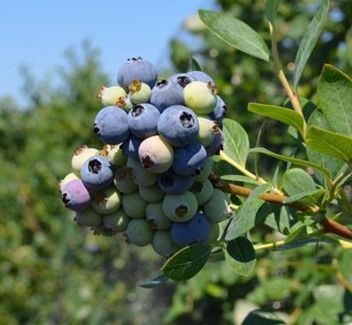
Credit: UF/IFAS Blueberry Breeding Program
Obsolete Cultivars for Florida
Few obsolete cultivars remain in commercial plantings in Florida. They are no longer recommended for new plantings in Florida.
‘Flicker’™ (U.S. PP21,554) (Figure 24) was released by the University of Florida in 2009. Although it was historically a major cultivar for evergreen production in central Florida, its ability to survive in the field came into question due to a high incidence of a fungicide-resistant, stem lesion form of anthracnose. ‘Flicker’™ is a vigorous, upright-to-spreading plant with potential for early harvest in an evergreen production system. However, production in this manner resulted in an extended harvest season, often lasting from early March through May. High vigor enables ‘Flicker’™ to carry a heavy crop, although there have been reports of poor establishment of young plants from liners. The reason for this is still unknown, but ‘Flicker’™ may not tolerate “wet feet” well or may be more susceptible to Phytophthora root rot than many southern highbush cultivars. Berries are large and light blue and grow in loose clusters that are easy to harvest by hand. Berries are firm with good flavor and a dry picking scar. Berries tend to retain their quality for an extended period while on the bush.

Credit: UF/IFAS Blueberry Breeding Program
‘Scintilla’ (U.S. PP19,233) was released by the University of Florida in 2007. It appears to have above-average susceptibility to Phytophthora root rot, leaf spots, and anthracnose, and its long-term field survival has been below average in numerous situations in Florida. It is a vigorous, semi-upright plant that produces a medium yield of large berries with excellent color, scar, firmness, and flavor. The berries grow in loose clusters and are easily harvested by hand. ‘Scintilla’ has a longer fruit development period, while its harvest is considered mid-season in Florida.
‘Star’ (U.S. PP10,675) (Figure 25) was released by the University of Florida in 1995 and was widely planted in the northern production areas of Florida and in southeast Georgia. It has not performed well south of Ocala, Florida, where it tended to produce few flowers and exhibit weak growth. Although ‘Star’ was historically a major cultivar for Florida and south Georgia, its ability to survive in the field came into question due to a high incidence of bacterial leaf scorch caused by the bacterium Xylella fastidiosa, and its apparent susceptibility to blueberry necrotic ring blotch virus. ‘Star’ has a slightly higher chill requirement than most other cultivars grown in Florida, and it is less likely to bloom in January or early February. ‘Star’ leafs well in Gainesville and southeastern Georgia but is less vigorous and smaller in stature than many cultivars. ‘Star’ has a very short bloom-to-ripe interval and a relatively compressed harvest season of about three weeks, with marginal yields reported in Florida. Berries are easy to harvest by hand, and the quality is excellent regarding size, firmness, and scar. Due to its slightly higher than average chill requirement, ‘Star’ is best adapted to north Florida and southeastern Georgia.

Credit: Jeff Williamson, UF/IFAS
‘Windsor’ (U.S. PP12,783) was released by the University of Florida in 2000 (Figure 26). Although it grows and fruits well, it has lost favor among Florida growers because of the deep picking scar that can tear at harvest, thus increasing packing costs and reducing postharvest fruit quality. There have been reports of greater-than-average susceptibility of ‘Windsor’ to hydrogen cyanamide injury. Because of these limitations, ‘Windsor’ is no longer widely grown in Florida. It is vigorous, with stout stems and a semi-spreading growth habit. ‘Windsor’ leafs out strongly as it begins to flower, and this strong leafing enables it to support a large crop. ‘Windsor’ berries are very large, especially early in the harvest season. Berry color is similar to ‘Star’. The berries are firm and have excellent flavor.
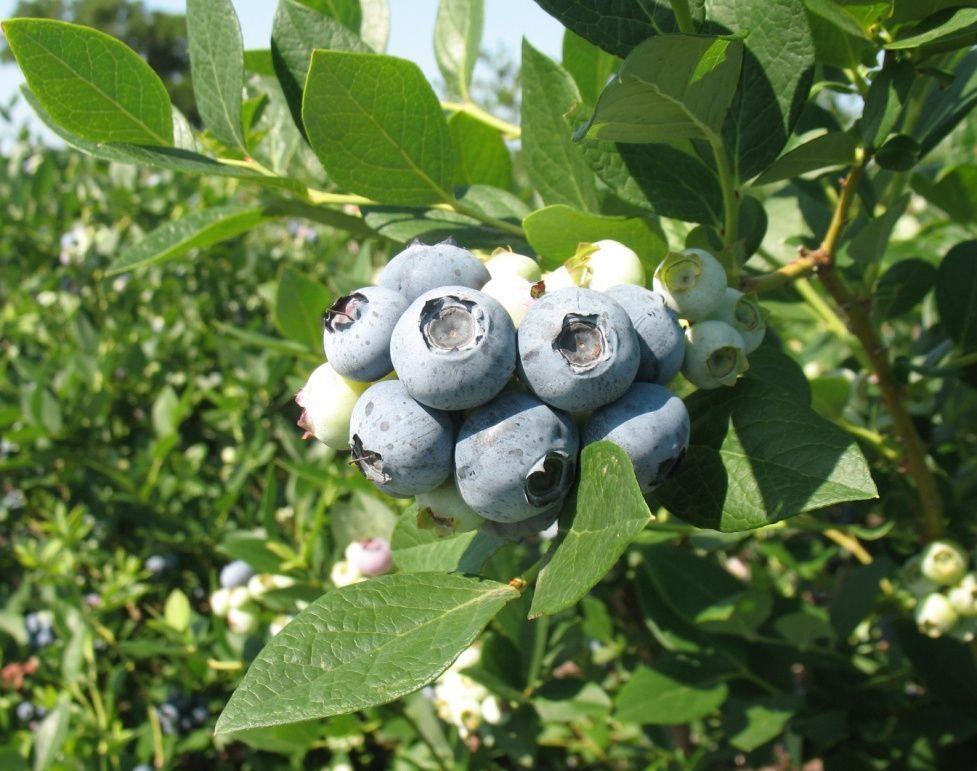
Credit: Jeff Williamson, UF/IFAS
Other Potential Cultivars
Blueberry production, especially in areas of Florida where southern highbush blueberries will be grown, has followed the same pattern of rapid expansion since the early 2000s. As a result, there has been an increase in the number of blueberry breeding programs, both public and private, that are developing southern highbush blueberry cultivars. Blueberry breeding programs at the University of Georgia, North Carolina State University, the University of Arkansas, and the United States Department of Agriculture Agricultural Research Service (Poplarville, Mississippi, and Beltsville, Maryland), as well as private companies, including Fall Creek Farm and Nursery (Lowell, Oregon), Driscoll’s, OzBlu, and Florida Blueberry Nursery, have all developed southern highbush blueberry cultivars. The University of Florida does not have sufficient data to report on the performance of cultivars from these programs. Growers interested in more information on these cultivars should contact the programs directly.
Propagation: Legal Requirements
The newer cultivars developed by the blueberry breeding program at the University of Florida are patented. This program is financed to a large extent by revenues from royalty payments on patented cultivars. Propagation of these cultivars requires a license.
Do you own a nursery and need a license?
To inquire about licenses for UF/IFAS cultivars, contact:
Florida Foundation Seed Producers, Inc.
3760 NW 83rd Street, Suite 2
Gainesville, FL 32606
Phone: (352) 317-0703
Email: jwatson@ffsp.net
Growers planting patented cultivars do not require a license if the plants were purchased from a nursery that holds a license to propagate these cultivars. Keep the documentation you receive from a licensed nursery indicating the plants were legally obtained. Propagation of patented cultivars without a license is a violation of the law, even if you own the plants from which the cuttings are taken.
Table 1. Characteristics of selected southern highbush blueberry cultivars.